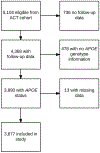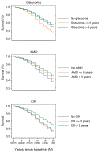Associations between recent and established ophthalmic conditions and risk of Alzheimer's disease
- PMID: 30098888
- PMCID: PMC6333518
- DOI: 10.1016/j.jalz.2018.06.2856
Associations between recent and established ophthalmic conditions and risk of Alzheimer's disease
Abstract
Introduction: Identifying ophthalmic diseases associated with increased risk of Alzheimer's disease (AD) may enable better screening and understanding of those at risk of AD.
Methods: Diagnoses of glaucoma, age-related macular degeneration (AMD), and diabetic retinopathy (DR) were based on International Classification of Diseases, 9th revision, codes for 3877 participants from the Adult Changes in Thought study. The adjusted hazard ratio for developing probable or possible AD for recent (within 5 years) and established (>5 years) diagnoses were assessed.
Results: Over 31,142 person-years of follow-up, 792 AD cases occurred. The recent and established hazard ratio were 1.46 (P = .01) and 0.87 (P = .19) for glaucoma, 1.20 (P = .12) and 1.50 (P < .001) for AMD, and 1.50 (P = .045) and 1.50 (P = .03) for DR.
Discussion: Increased AD risk was found for recent glaucoma diagnoses, established AMD diagnoses, and both recent and established DR. People with certain ophthalmic conditions may have increased AD risk.
Keywords: Adult Changes in Thought (ACT); Age-related macular degeneration; Alzheimer's disease; Cataract; Diabetic retinopathy; Glaucoma; Ophthalmology.
Copyright © 2018 the Alzheimer's Association. Published by Elsevier Inc. All rights reserved.
Figures


Comment in
-
Alzheimer's disease and glaucoma: Look-alike neurodegenerative diseases.Alzheimers Dement. 2019 Apr;15(4):600-601. doi: 10.1016/j.jalz.2018.12.012. Epub 2019 Jan 31. Alzheimers Dement. 2019. PMID: 30713020 No abstract available.
References
-
- World Alzheimer report 2015, the global impact of dementia. Available at: http://www.alz.co.uk/research/WorldAlzheimerReport2015.pdf. Accessed March 13, 2017.
-
- Alzheimer’s Association. 2015 Alzheimer’s disease facts and figures. Alzheimers Dement 2015;11:332–84. - PubMed
-
- London A, Benhar I, Schwartz M. The retina as a window to the brain-from eye research to CNS disorders. Nat Rev Neurol 2013;9:44–53. - PubMed
MeSH terms
Grants and funding
LinkOut - more resources
Full Text Sources
Other Literature Sources
Medical

